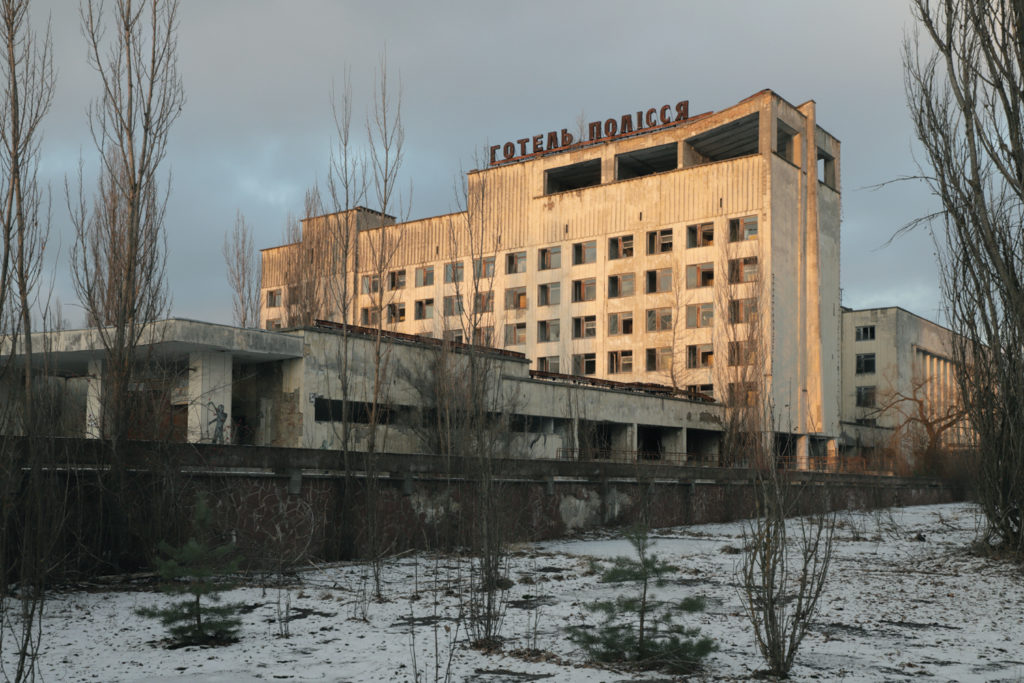
Pripyat rooftops, view through a ventilation slot in the roof space of a residential tower block. The power plant, complete with the New Arch, can be seen on the horizon. © Darmon Richter / FUEL Publishing

A tame fox poses in front of the sign pointing the way to Pripyat from the Chernobyl Nuclear Power Plant. © Darmon Richter / FUEL Publishing

A view from 2013 across Pripyat rooftops towards the Chernobyl Nuclear Power Plant. The New Arch is still under construction, while the old sarcophagus enclosing Reactor Block 4 stands to its left. © Darmon Richter / FUEL Publishing

Kindergarten No.7 ‘Zolotoy Klyuchik’ (‘Golden Key’), Pripyat. Discarded artefacts are arranged into unlikely dioramas by visitors. © Darmon Richter / FUEL Publishing

Post Office, Pripyat. The mural illustrates the evolution of communication, from stone tablets and scrolls, to mail trains and finally a Soviet cosmonaut. © Darmon Richter / FUEL Publishing

Rooftops, central Pripyat. The back of the hammer-and-sickle emblem from the tower block roof. This symbol would have been brightly lit at night. © Darmon Richter / FUEL Publishing

‘Polissya’ Hotel, Pripyat. Once the tallest building in the city, the hotel hosted scientists, engineers and politicians visiting from other parts of the Soviet Union. © Darmon Richter / FUEL Publishing

Abandoned trolleybus, Kopachi, Chernobyl Exclusion Zone. This highly contaminated village was mostly bulldozed after the disaster. In April 2020 this vehicle was severely damaged by forest fires. © Darmon Richter / FUEL Publishing

Logging track, Chernobyl Exclusion Zone. Illegal visitors to the Zone typically prefer these remote paths, rather than the main roads which are frequented by police patrols and tour buses. © Darmon Richter / FUEL Publishing

Ferris Wheel, Pripyat. Though the city was evacuated before its official May Day opening ceremony, the wheel saw occasional use before the disaster, contrary to popular belief. © Darmon Richter / FUEL Publishing

Control Room 3, Chernobyl Nuclear Power Plant. This room and the associated Reactor 3 remained in use until 1995 when they were put out of service following an agreement with the EU. Now, along with Reactors 1 and 2, it is undergoing a decommissioning process. © Darmon Richter / FUEL Publishing

Control Room 2, Chernobyl Nuclear Power Plant. A tourist studies the consoles, decommissioned after a fire in 1991. The controls are no longer operational and occasionally plant employees will allow visitors to push buttons and switches. © Darmon Richter / FUEL Publishing

Control Room 3. The top left of these cube-shaped shielded buttons marked A3-5 – or ‘AZ-5’ –
was the ‘scram’ kill switch. This manually operated control would immediately terminate the fission reaction by inserting all the control rods at once. In neighbouring Control Room 4, on 26 April 1986 at 1.23.40am, this switch was flicked and a malfunction occurred, causing the meltdown. © Darmon Richter / FUEL Publishing

Chernobyl: A Stalkers’ Guide by Darmon Richter is out now, published via Fuel.
Writer and photographer Darmon Richter exposes a side of Chernobyl rarely seen by tourists in his new book dedicated to ‘redefining and de-sensationalising’ the region.

Richter, who has been photographing the area for the last seven years, wanted to paint a picture of what he describes as ‘the real Chernobyl’, going beyond the tiny fraction of places most visitors to the region see.
‘I think a lot of the tourism to Chernobyl now serves as a kind of “confirmation bias” for the picture of Chernobyl that most people already have in their heads,’ he explains. ‘But for the people who live and work in the Chernobyl Zone today, the place looks quite different.’
To venture outside of the tourist bubble, Richter embarked on an illicit hike into the 1,000-square-mile exclusion zone, journeying through irradiated forests, empty villages and past mega-structures to uncover a less familiar vision of Chernobyl.

His images show wildlife frolicking in abandoned ruins – many of which are descendants of deserted pets – communist murals that have barely faded and apartment blocks that seem barely changed. Richter also ventured into the nuclear plant’s control rooms.
‘The number of tourists entering the Zone each day averages less than 5% of Chernobyl’s total human traffic,’ he says. ‘This book is more interested in the other 95%.’
Chernobyl: A Stalkers’ Guide by Darmon Richter is out now, published via Fuel




See more of Richter’s photo essays exploring Soviet-era architecture on The Spaces























